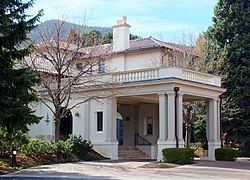Built 1910 (1910) CSRHP # 5EP.377 Opened 1910 | NRHP Reference # 95001328 Designated CSRHP 1995 Area 7 ha Added to NRHP 22 November 1995 | |
 | ||
Architectural style Mission Revival and Spanish Revival Similar Colorado Springs City Audit, Will Rogers Shrine of the Sun, Rock Ledge Ranch Hi, North Cheyenne Cañon P, Glen Eyrie | ||
The El Pomar Estate was the Penrose House and estate of Spencer and Julie Penrose in the Broadmoor, Colorado, Colorado Springs, Colorado It is listed on the National Register of Historic Places listings in El Paso County, Colorado and the Colorado State Register of Historic Properties.
Contents
William F. Dixon
Pioneer William F. Dixon, the first to settle in Cheyenne Canon, claimed the land in 1862 for what would be the Dixon Ranch and orchard. He built irrigation ditches for his farm and orchard and raised cattle. A portion of his property that had been apple orchards became the El Pomar estate.
The Potter estate
In 1909 or 1910, Grace Goodyear Depew built a Spanish style single-story house named El Pomar, Spanish for "the apple orchard". In April 1910, Grace married Captain Howard Ashton Potter. Mr. Potter lived in another house on the estate when the couple's relationship became strained and he died in 1913. Grace Potter died in 1914. Author Julian Street called it the "house of houses" in Colorado Springs, not knowing one in the country that "fits its setting better than this one, or which is more perfect thing from every point of view."
The Penrose estate
Spencer and Julie Penrose purchased El Pomar, the Potter's wine cellar collection, and house furnishings in 1916 for $75,000 (equivalent to $1,650,688 in 2016) near The Broadmoor, a resort that they had built following a European vacation. They added second and third floors to the house. The estate buildings included the main house, gate lodge, carriage house, gardener's cottage, chauffeur's cottage, and a teahouse. Furnishings purchased for built for the Penroses that remain in El Pomar include Vermont Corona and Belgian black marble, a rare Aeolian organ with ceiling decorations over vents that allowed organ music to drift throughout the house, secret doors that held a wine cellar in the library during Prohibition, and some furnishings.
James Bell, who had been president of the National Association of Gardeners, was superintendent of El Pomar until his death in 1920.
Sisters of Charity retreat
In 1944, following her husband's death in 1939, Julie Penrose moved out of El Pomar and into a penthouse suite at The Broadmoor. She donated the estate to The Sisters of Charity of Cincinnati, who used it as a spiritual retreat center for almost 50 years. Named the Julie Penrose Center, it was the first Catholic retreat center for women west of the Mississippi. It was administered by the Roman Catholic Archdiocese of Denver.
El Pomar Foundation
In 1992, El Pomar became the headquarters for the El Pomar Foundation, founded by Spencer and Julie Penrose in 1937. The foundation initiated a restoration of the estate in 1992 to be used as a conference center, while preserving the integrity of the original architecture. The estate is now the Penrose House Nonprofit Conference and Education Center for non-profit organizations. It has been visited by Margaret Thatcher, Mikhail Gorbachev, and George H. W. Bush, former heads of state.
